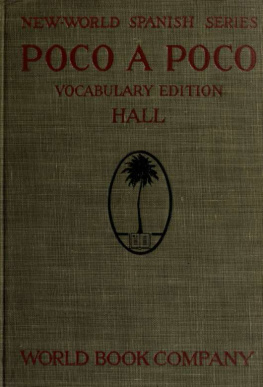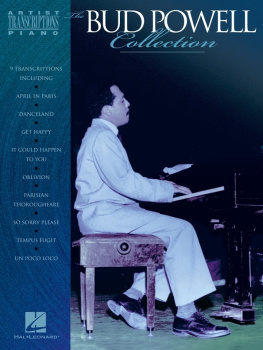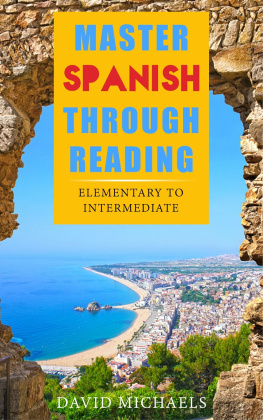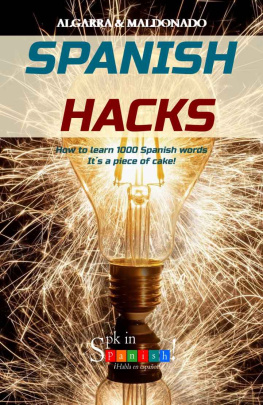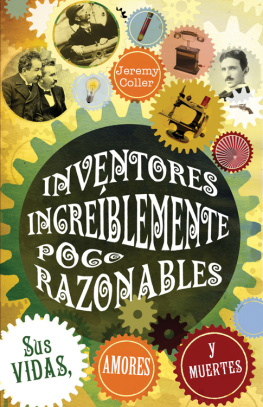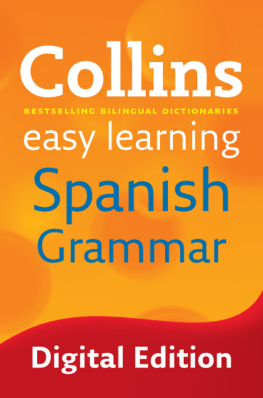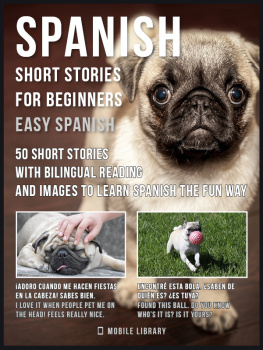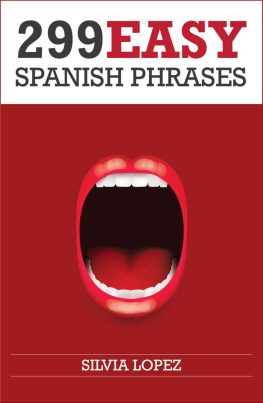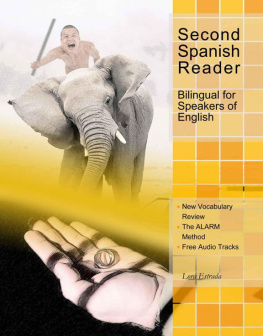Hall Aviles - Poco a poco; an elementary direct method for learning Spanish
Here you can read online Hall Aviles - Poco a poco; an elementary direct method for learning Spanish full text of the book (entire story) in english for free. Download pdf and epub, get meaning, cover and reviews about this ebook. year: 1922, publisher: Yonkers-on-Hudson, N.Y., World Book Company, genre: Detective and thriller. Description of the work, (preface) as well as reviews are available. Best literature library LitArk.com created for fans of good reading and offers a wide selection of genres:
Romance novel
Science fiction
Adventure
Detective
Science
History
Home and family
Prose
Art
Politics
Computer
Non-fiction
Religion
Business
Children
Humor
Choose a favorite category and find really read worthwhile books. Enjoy immersion in the world of imagination, feel the emotions of the characters or learn something new for yourself, make an fascinating discovery.
- Book:Poco a poco; an elementary direct method for learning Spanish
- Author:
- Publisher:Yonkers-on-Hudson, N.Y., World Book Company
- Genre:
- Year:1922
- Rating:5 / 5
- Favourites:Add to favourites
- Your mark:
- 100
- 1
- 2
- 3
- 4
- 5
Poco a poco; an elementary direct method for learning Spanish: summary, description and annotation
We offer to read an annotation, description, summary or preface (depends on what the author of the book "Poco a poco; an elementary direct method for learning Spanish" wrote himself). If you haven't found the necessary information about the book — write in the comments, we will try to find it.
Hall Aviles: author's other books
Who wrote Poco a poco; an elementary direct method for learning Spanish? Find out the surname, the name of the author of the book and a list of all author's works by series.
Poco a poco; an elementary direct method for learning Spanish — read online for free the complete book (whole text) full work
Below is the text of the book, divided by pages. System saving the place of the last page read, allows you to conveniently read the book "Poco a poco; an elementary direct method for learning Spanish" online for free, without having to search again every time where you left off. Put a bookmark, and you can go to the page where you finished reading at any time.
Font size:
Interval:
Bookmark:




These symbols are words and the groups of words that we call sentences. To employ these symbols spontaneously and correctly their use must be a habit. Now habit is the result of doing the same thing many times. In other words, correct speech is the result not so much of knowledge as of habit. If anyone doubts the truth of this assertion, let him go to hear some public speaker and listen carefully for slips in grammar and in pronunciation. He is likely to find them aplenty.
Why? Because the speaker does not know better? No, not that; but simply because under stress of enthusiasm or of emotion the man lapses unconsciously into the language heard in his early youththat is, of the period before he studied grammar and rhetoric. It follows, then, since correct speech is a habit, and habits are built up by repetition, that the young student needs much practice. In this book the required practice is provided by the Prdctica en el Uso de Las Formas and by very abundant Ejercicios, Cuestionarios and Composi-ciones. Yet another thing is important. If the student is to speak the language, he must previously hear it. The iii human ear does not recognize the sounds it has never heard.
Children who are born deaf rarely learn to speak. The congenitally blind deaf-mutes are not mute because they cannot see, but because they cannot hear. The mute graduates of our classes in modern languages, let us add, are mute in spite of having seen much of the language, simply because they have not heard it. It must be remembered also that first impressions are strongest and most lasting, and their first impressions have been through the eye. For these reasons, and for others that cannot be discussed in limited space, the author believes that the lessons of this book should be presented orally before the student sees the words in print. Let the ear learn to recognize the sound of the basic words of the language.
The eye will help the ear afterwards. If we reverse the process, the eye simply builds up its own separate memory groups and is a hindrance rather than a help. Specific suggestions as to method, word lists, hints for presentation, etc., will be found in the Teacher's Manual, which may be obtained from the publishers. In Parte Segunda will be found much valuable reference material, models for correspondence, rules, explanations of vocabulary, irregular forms, conjugations, forms of adjectives, pronouns, etc., and at the end, a complete index arranged first by heading of subject-matter, and second by words whose grammatical peculiarities are treated. In conclusion, the author wishes to thank his friends and fellow teachers who have contributed by helpful suggestions to make what he hopes will be found a practical and interesting method of learning the first two thousand words. TABLA DE MATERIAS PARTE PRIMERA PAGINA LeCCI(5n PRIMERA 1 Lecci6n segunda 4 Lecci6n tercera 8 Lecci6n cuarta 12 Lecci6n quinta 16 Lecci6n sexta 20 Lecci6n septima 25 Lecci6n octava : 29 Lecci6n novena 34 Lecci6n decima 38 Lecci6n undecima 42 Lecci6n duodecima 47 Lecci6n decimotercia 51 Lecci6n decimocuarta 56 Lecci6n decimoquinta 62 Lecci6n decimosexta 67 Lecci6n decimoseptima 73 Lecci6n decimoctava 78 Lecci6n decimonona 84 Lecci6n vigesima 89 Lecci6n vigesima primera 95 Lecci6n vigesima segunda 99 Lecci6n vigesima tercera 104 Lecci6n vigesima cuarta 110 Lecci6n vigesima quinta 117 Lecci6n vigesima sexta 123 Lecci6n vigesima septima 128 Lecci6n vigesima octava 134 Lecci6n vigesima nona 140 Lecci6n trigesima 146 Lecci6n trigesima primera 152 Lecci6n trigesima segunda 159 Lecci6n trigesima tercera 165 Lecci6n trigesima cuarta 172 Lecci6n trigesima quinta 179 Lecci6n trigesima sexta 186 Lecci6n trigesima septima 194 Lecci6n trigesima octava 204 pagina LiECCION TRIGESIMA NONA 210 Lecci6n cuadragesima 216 PARTE SEGUNDA A.
Modelos de Cartas y de Formas Comerciales... 225 B. Explicaciones Gramaticales 239 C. Tablas Gramaticales (1) Los Verbos Indice de Conjugaciones 277 Conjugaci6n de los Verbos 278 Tabla de las Terminaciones de los Verbos Regu lares de las Tres Conjugaciones 282 Notas sobre la Conjugaci6n de algunos Verbos Irregulares 283 Verbos Irregulares Clasificados 284 Verbos Irregulares no Clasificados 290 Participios Irregulares 295 Lista de Formas Irregulares 295 (2) Articulos, Adjectivos y Pronombres 298 D. Indice Gramatical (1) Por Materia 303 (2) Por Palabras 306 POCO A POCO POCO A POCO PARTE PRIMERA LECCION PRIMERA  El elefante La rata 1. ; iQue es el elefante? Es un animal. ^Es la rata un animal? Si, senor. ^Es la rata un animal? Si, senor.
El elefante La rata 1. ; iQue es el elefante? Es un animal. ^Es la rata un animal? Si, senor. ^Es la rata un animal? Si, senor.
El elefante y la rata son animales. Qu6 son el elefante y la mula? El elefante y la mula son animales. El elefante es un animal grande. ^Es grande la rata? No, senor; la rata no es grande; es pequefia. Si; la rata es un animal pequeno. ^Son pequefios los caballos? ^^ No, senor; son ^Cual es el animal mas grande? Ei ca baiio La mula El elefante. ^. ^Cuales son los animales pequefios? j*f *\ Las rat as. \*/W^4 iSon grandes los burros? J Jf No, senor; son pequefios. ei burro rf  Poco a Poco 2. prActica en el uso de las formas i
Poco a Poco 2. prActica en el uso de las formas i  Dos ratas Aprendase de memoria y repitase con el libro cerrado: 1 El elefante es grande. prActica en el uso de las formas i
Dos ratas Aprendase de memoria y repitase con el libro cerrado: 1 El elefante es grande. prActica en el uso de las formas i  Dos ratas Aprendase de memoria y repitase con el libro cerrado: 1 El elefante es grande.
Dos ratas Aprendase de memoria y repitase con el libro cerrado: 1 El elefante es grande.
Los elefantes son grandes. El burro es pequeno. Los burros son pequenos. Larata es, pequena. Las ratas son pequenas. El caballo no es pequeno.
La mula no es pequena. El elefante y el caballo no son pequenos. El caballo y la mula no son pequenos. ^Es pequeno el caballo? ^Son pequenos los caballos? ^Es pequena la rata? ^Son pequenas las ratas? No es grande el elefante? iNo son grandes los elefantes? Un caballo y un caballo son dos (2) caballos. Una mula y una mula son dos mulas.  Dos caballos 3.
Dos caballos 3.
FRASES tfTILES Para aprenderse de memoria: iQue' es? iCual es? iQue* son? ^Cuales son? 1 El profesor instruira a los alumnos convenientemente en el curso de las lecciones explicandoles la manera de estudiar lo que se encuentra bajo los encabezamientos Prdctica en el Uso de las Formas, Frases utiles, Ejercicio y Cuestionario. Las palabras de estas direcciones no se cuentan como parte del vocabulario del libro. 4. EJERCICIO A. TTsese la forma apropiada del artfculo determinado en singular, el o la: burro animal mula caballo rata elefante B. iCuales son las palabras de la leccion que se escriben con acento grafico (')? D. ^Cuales son las palabras que se escriben con n? E. ^Cuales son las palabras que se escriben con n? E.
Font size:
Interval:
Bookmark:
Similar books «Poco a poco; an elementary direct method for learning Spanish»
Look at similar books to Poco a poco; an elementary direct method for learning Spanish. We have selected literature similar in name and meaning in the hope of providing readers with more options to find new, interesting, not yet read works.
Discussion, reviews of the book Poco a poco; an elementary direct method for learning Spanish and just readers' own opinions. Leave your comments, write what you think about the work, its meaning or the main characters. Specify what exactly you liked and what you didn't like, and why you think so.

